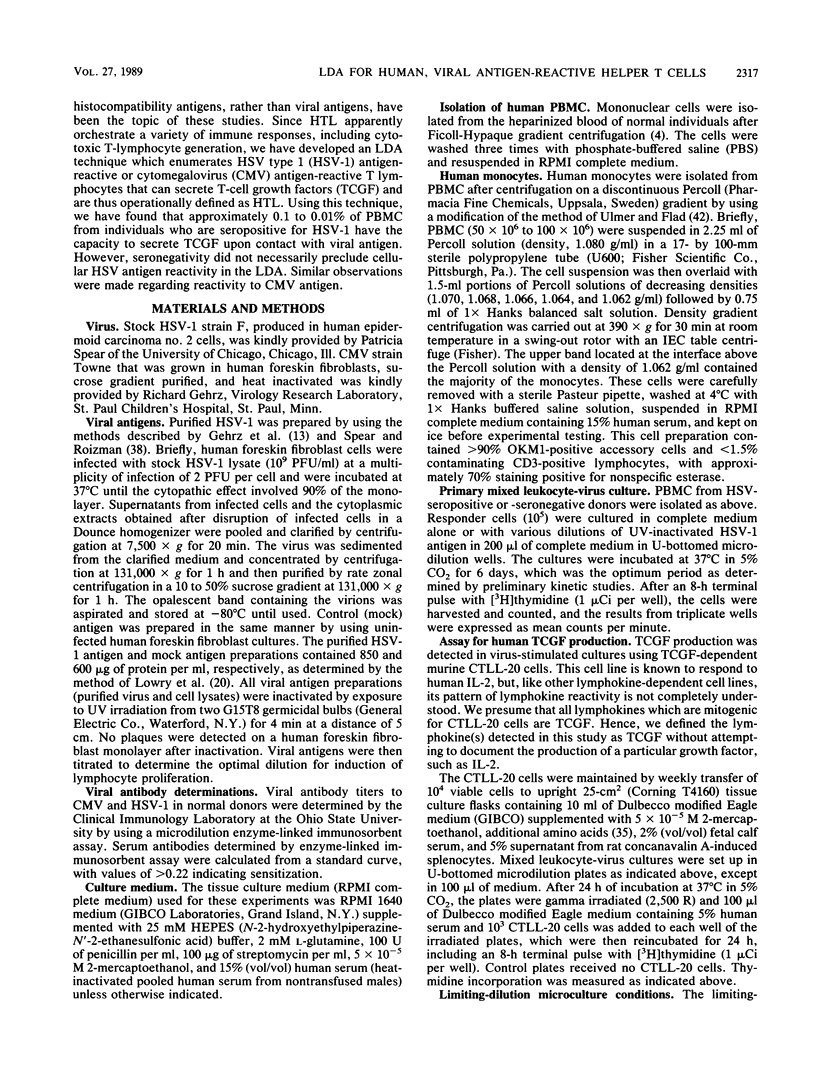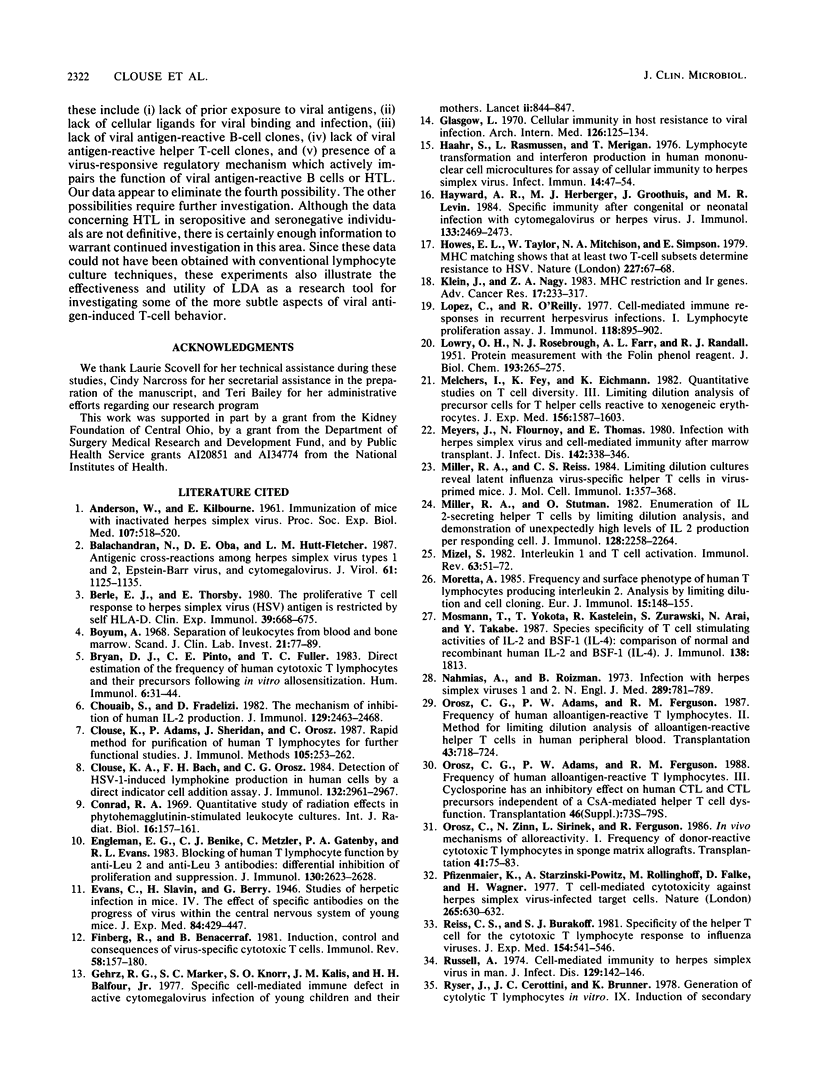Abstract
A limiting-dilution analysis technique was developed which enumerates human T cells with the capacity to secrete T-cell growth factors such as interleukin 2 after contact with herpes simplex virus type 1 (HSV-1) or cytomegalovirus (CMV) antigens (operationally defined as virus-reactive helper T cells [HTL]). By using this limiting-dilution analysis technique, the peripheral blood of HSV-seropositive individuals was analyzed for the frequency of HSV antigen-reactive HTL and for the ability either to proliferate or to secrete detectable T-cell growth factors in conventional HSV antigen-stimulated lymphocyte cultures. We found that the magnitudes of the latter two responses did not correlate directly with the frequency estimates of HSV antigen-reactive HTL. The study was expanded to analyze both HSV and CMV reactivities within individuals. Those who were seropositive for HSV or CMV were found to have relatively high HTL frequencies for the viral antigens to which they were sensitized. However, those who were seronegative for one of the viruses often had HTL reactive with that virus in their peripheral blood. These latter HTL frequencies were highly variable and ranged from undetectable to quite prominent, even within the same individual at different times. In general, it was found that viral antigen-reactive serologic activity does not necessarily reflect the status of viral antigen-reactive cell-mediated immunity in humans and that viral antigen-induced T-cell responses may be unexpectedly complex, rather than absent, in individuals who are seronegative for a particular virus.
Full text
PDF







Selected References
These references are in PubMed. This may not be the complete list of references from this article.
- ANDERSON W. A., KILBOURNE E. D. Immunization of mice with inactivated herpes simplex virus. Proc Soc Exp Biol Med. 1961 Jul;107:518–520. doi: 10.3181/00379727-107-26673. [DOI] [PubMed] [Google Scholar]
- Balachandran N., Oba D. E., Hutt-Fletcher L. M. Antigenic cross-reactions among herpes simplex virus types 1 and 2, Epstein-Barr virus, and cytomegalovirus. J Virol. 1987 Apr;61(4):1125–1135. doi: 10.1128/jvi.61.4.1125-1135.1987. [DOI] [PMC free article] [PubMed] [Google Scholar]
- Berle E. J., Jr, Thorsby E. The proliferative T cell response to herpes simplex virus (HSV) antigen is restricted by self HLA-D. Clin Exp Immunol. 1980 Mar;39(3):668–675. [PMC free article] [PubMed] [Google Scholar]
- Bryan D. J., Pinto C. E., Fuller T. C. Direct estimation of the frequency of human cytotoxic T lymphocytes and their precursors following in vitro allosensitization. Hum Immunol. 1983 Jan;6(1):31–44. doi: 10.1016/0198-8859(83)90071-x. [DOI] [PubMed] [Google Scholar]
- Chouaib S., Fradelizi D. The mechanism of inhibition of human IL 2 production. J Immunol. 1982 Dec;129(6):2463–2468. [PubMed] [Google Scholar]
- Clouse K. A., Bach F. H., Orosz C. G. Detection of HSV-1-induced lymphokine production in human cells by a direct indicator cell addition assay. J Immunol. 1984 Jun;132(6):2961–2967. [PubMed] [Google Scholar]
- Clouse K., Adams P., Sheridan J., Orosz C. Rapid method for purification of human T lymphocytes for further functional studies. J Immunol Methods. 1987 Dec 24;105(2):253–262. doi: 10.1016/0022-1759(87)90273-0. [DOI] [PubMed] [Google Scholar]
- Engleman E. G., Benike C. J., Metzler C., Gatenby P. A., Evans R. L. Blocking of human T lymphocyte functions by anti-Leu-2 and anti-Leu-3 antibodies: differential inhibition of proliferation and suppression. J Immunol. 1983 Jun;130(6):2623–2628. [PubMed] [Google Scholar]
- Finberg R., Benacerraf B. Induction, control and consequences of virus specific cytotoxic T cells. Immunol Rev. 1981;58:157–180. doi: 10.1111/j.1600-065x.1981.tb00353.x. [DOI] [PubMed] [Google Scholar]
- Gehrz R. C., Marker S. C., Knorr S. O., Kalis J. M., Balfour H. H., Jr Specific cell-mediated immune defect in active cytomegalovirus infection of young children and their mothers. Lancet. 1977 Oct 22;2(8043):844–847. doi: 10.1016/s0140-6736(77)90782-6. [DOI] [PubMed] [Google Scholar]
- Glasgow L. A. Cellular immunity in host resistance to viral infections. Arch Intern Med. 1970 Jul;126(1):125–134. [PubMed] [Google Scholar]
- Haahr S., Rasmussen L., Merigan T. C. Lymphocyte transformation and interferon production in human mononuclear cell microcultures for assay of cellular immunity to herpes simplex virus. Infect Immun. 1976 Jul;14(1):47–54. doi: 10.1128/iai.14.1.47-54.1976. [DOI] [PMC free article] [PubMed] [Google Scholar]
- Hayward A. R., Herberger M. J., Groothuis J., Levin M. R. Specific immunity after congenital or neonatal infection with cytomegalovirus or herpes simplex virus. J Immunol. 1984 Nov;133(5):2469–2473. [PubMed] [Google Scholar]
- Howes E. L., Taylor W., Mitchison N. A., Simpson E. MHC matching shows that at least two T-cell subsets determine resistance to HSV. Nature. 1979 Jan 4;277(5691):66–68. doi: 10.1038/277067a0. [DOI] [PubMed] [Google Scholar]
- LOWRY O. H., ROSEBROUGH N. J., FARR A. L., RANDALL R. J. Protein measurement with the Folin phenol reagent. J Biol Chem. 1951 Nov;193(1):265–275. [PubMed] [Google Scholar]
- Lopez C., O'Reilly R. J. Cell-mediated immune responses in recurrent herpesvirus infections. I. Lymphocyte proliferation assay. J Immunol. 1977 Mar;118(3):895–902. [PubMed] [Google Scholar]
- Melchers I., Fey K., Eichmann K. Quantitative studies on T cell diversity. III. Limiting dilution analysis of precursor cells for T helper cells reactive to xenogeneic erythrocytes. J Exp Med. 1982 Dec 1;156(6):1587–1603. doi: 10.1084/jem.156.6.1587. [DOI] [PMC free article] [PubMed] [Google Scholar]
- Meyers J. D., Flournoy N., Thomas E. D. Infection with herpes simplex virus and cell-mediated immunity after marrow transplant. J Infect Dis. 1980 Sep;142(3):338–346. doi: 10.1093/infdis/142.3.338. [DOI] [PubMed] [Google Scholar]
- Miller R. A., Reiss C. S. Limiting dilution cultures reveal latent influenza virus-specific helper T cells in virus-primed mice. J Mol Cell Immunol. 1984;1(6):357–368. [PubMed] [Google Scholar]
- Miller R. A., Stutman O. Enumeration of IL 2-secreting helper T cells by limiting dilution analysis, and demonstration of unexpectedly high levels of IL 2 production per responding cell. J Immunol. 1982 May;128(5):2258–2264. [PubMed] [Google Scholar]
- Mizel S. B. Interleukin 1 and T cell activation. Immunol Rev. 1982;63:51–72. doi: 10.1111/j.1600-065x.1982.tb00411.x. [DOI] [PubMed] [Google Scholar]
- Mogensen C. E. The glomerular permeability determined by dextran clearance using Sephadex gel filtration. Scand J Clin Lab Invest. 1968;21(1):77–82. doi: 10.3109/00365516809076979. [DOI] [PubMed] [Google Scholar]
- Moretta A. Frequency and surface phenotype of human T lymphocytes producing interleukin 2. Analysis by limiting dilution and cell cloning. Eur J Immunol. 1985 Feb;15(2):148–155. doi: 10.1002/eji.1830150208. [DOI] [PubMed] [Google Scholar]
- Mosmann T. R., Yokota T., Kastelein R., Zurawski S. M., Arai N., Takebe Y. Species-specificity of T cell stimulating activities of IL 2 and BSF-1 (IL 4): comparison of normal and recombinant, mouse and human IL 2 and BSF-1 (IL 4). J Immunol. 1987 Mar 15;138(6):1813–1816. [PubMed] [Google Scholar]
- Nahmias A. J., Roizman B. Infection with herpes-simplex viruses 1 and 2. 3. N Engl J Med. 1973 Oct 11;289(15):781–789. doi: 10.1056/NEJM197310112891505. [DOI] [PubMed] [Google Scholar]
- Orosz C. G., Adams P. W., Ferguson R. M. Frequency of human alloantigen-reactive T lymphocytes. II. Method for limiting dilution analysis of alloantigen-reactive helper T cells in human peripheral blood. Transplantation. 1987 May;43(5):718–724. [PubMed] [Google Scholar]
- Orosz C. G., Adams P. W., Ferguson R. M. Frequency of human alloantigen-reactive T lymphocytes. III. Evidence that cyclosporine has an inhibitory effect on human CTL and CTL precursors, independent of CsA-mediated helper T cell dysfunction. Transplantation. 1988 Aug;46(2 Suppl):73S–79S. [PubMed] [Google Scholar]
- Orosz C. G., Zinn N. E., Sirinek L., Ferguson R. M. In vivo mechanisms of alloreactivity. I. Frequency of donor-reactive cytotoxic T lymphocytes in sponge matrix allografts. Transplantation. 1986 Jan;41(1):75–83. [PubMed] [Google Scholar]
- Pfizenmaier K., Starzinski-Powitz A., Röllinghoff M., Falks D., Wagner H. T-cell-mediated cytotoxicity against herpes simplex virus-infected target cells. Nature. 1977 Feb 17;265(5595):630–632. doi: 10.1038/265630a0. [DOI] [PubMed] [Google Scholar]
- Reiss C. S., Burakoff S. J. Specificity of the helper T cell for the cytolytic T lymphocyte response to influenza viruses. J Exp Med. 1981 Aug 1;154(2):541–546. doi: 10.1084/jem.154.2.541. [DOI] [PMC free article] [PubMed] [Google Scholar]
- Russell A. S. Cell-mediated immunity to herpes simplex virus in man. J Infect Dis. 1974 Feb;129(2):142–146. doi: 10.1093/infdis/129.2.142. [DOI] [PubMed] [Google Scholar]
- Ryser J. E., Cerottini J. C., Brunner K. T. Generation of cytolytic T lymphocytes in vitro. IX. induction of secondary CTL responses in primary long-term MLC by supernatants from secondary MLC. J Immunol. 1978 Feb;120(2):370–377. [PubMed] [Google Scholar]
- Sethi K. K., Stroehmann I., Brandis H. Human T-cell cultures from virus-sensitized donors can mediate virus-specific and HLA-restricted cell lysis. Nature. 1980 Aug 14;286(5774):718–720. doi: 10.1038/286718a0. [DOI] [PubMed] [Google Scholar]
- Shiraki K., Okuno T., Yamanishi K., Takahashi M. Polypeptides of varicella-zoster virus (VZV) and immunological relationship of VZV and herpes simplex virus (HSV). J Gen Virol. 1982 Aug;61(Pt 2):255–269. doi: 10.1099/0022-1317-61-2-255. [DOI] [PubMed] [Google Scholar]
- Spear P. G., Roizman B. Proteins specified by herpes simplex virus. V. Purification and structural proteins of the herpesvirion. J Virol. 1972 Jan;9(1):143–159. doi: 10.1128/jvi.9.1.143-159.1972. [DOI] [PMC free article] [PubMed] [Google Scholar]
- Starr S. E., Karatela S. A., Shore S. L., Duffey A., Nahmias A. J. Stimulation of human lymphocytes by Herpes simplex virus antigens. Infect Immun. 1975 Jan;11(1):109–112. doi: 10.1128/iai.11.1.109-112.1975. [DOI] [PMC free article] [PubMed] [Google Scholar]
- Stockinger B. Cytotoxic T-cell precursors revealed in neonatally tolerant mice. Proc Natl Acad Sci U S A. 1984 Jan;81(1):220–223. doi: 10.1073/pnas.81.1.220. [DOI] [PMC free article] [PubMed] [Google Scholar]
- Taswell C. Limiting dilution assays for the determination of immunocompetent cell frequencies. I. Data analysis. J Immunol. 1981 Apr;126(4):1614–1619. [PubMed] [Google Scholar]
- Ulmer A. J., Flad H. D. Discontinuous density gradient separation of human mononuclear leucocytes using Percoll as gradient medium. J Immunol Methods. 1979;30(1):1–10. doi: 10.1016/0022-1759(79)90268-0. [DOI] [PubMed] [Google Scholar]
- Vie H., Miller R. A. Estimation by limiting dilution analysis of human IL 2-secreting T cells: detection of IL 2 produced by single lymphokine-secreting T cells. J Immunol. 1986 May 1;136(9):3292–3297. [PubMed] [Google Scholar]
- Woodruff J. F., Woodruff J. J. T lymphocyte interaction with viruses and virus-infected tissues. Prog Med Virol. 1975;19:120–160. [PubMed] [Google Scholar]
- Yasukawa M., Zarling J. M. Human cytotoxic T cell clones directed against herpes simplex virus-infected cells. I. Lysis restricted by HLA class II MB and DR antigens. J Immunol. 1984 Jul;133(1):422–427. [PubMed] [Google Scholar]
- Zaia J. A., Leary P. L., Levin M. J. Specificity of the blastogenic response of human mononuclear cells to herpesvirus antigens. Infect Immun. 1978 Jun;20(3):646–651. doi: 10.1128/iai.20.3.646-651.1978. [DOI] [PMC free article] [PubMed] [Google Scholar]


